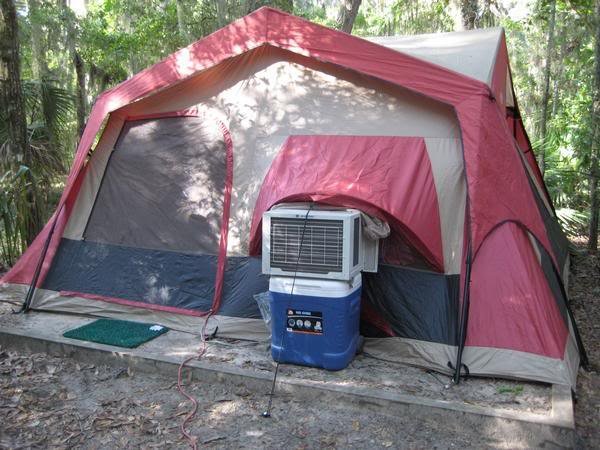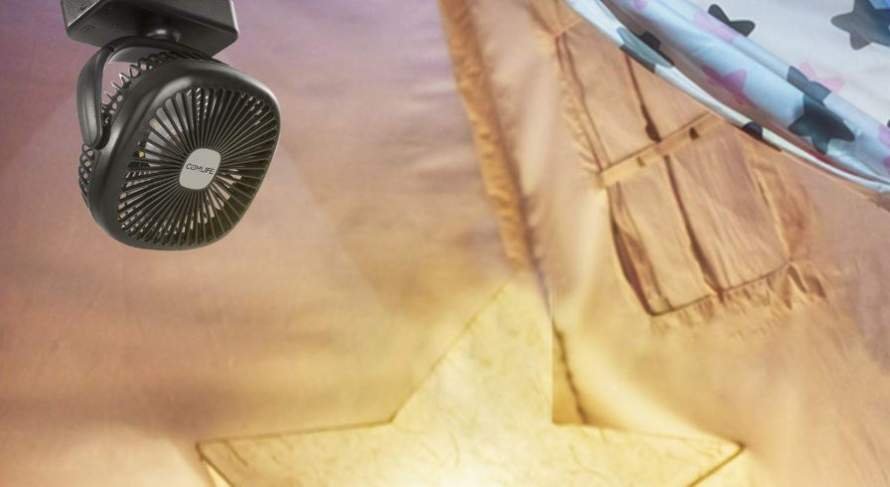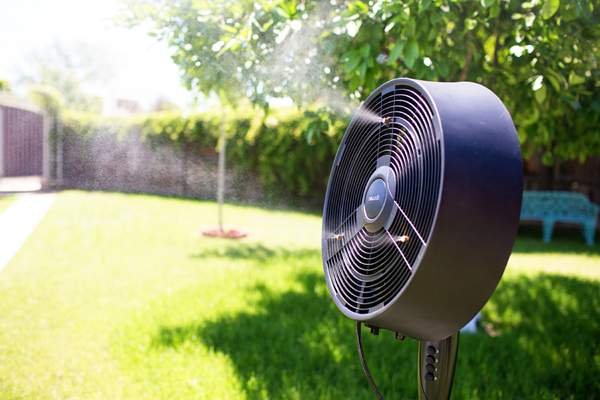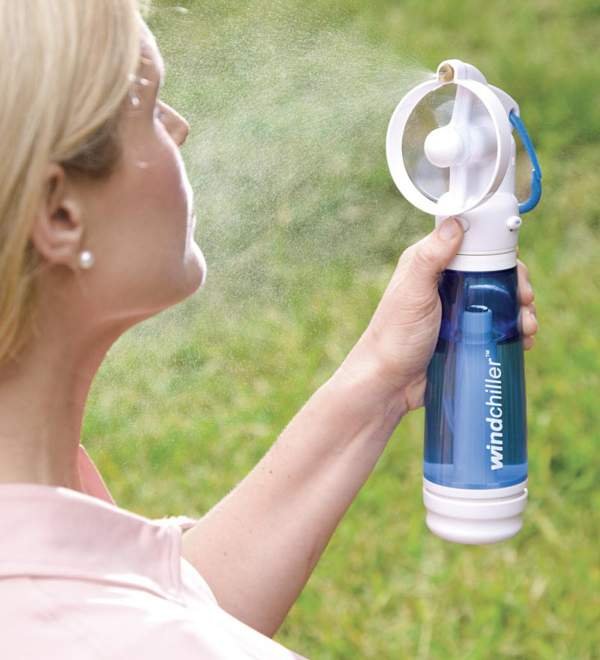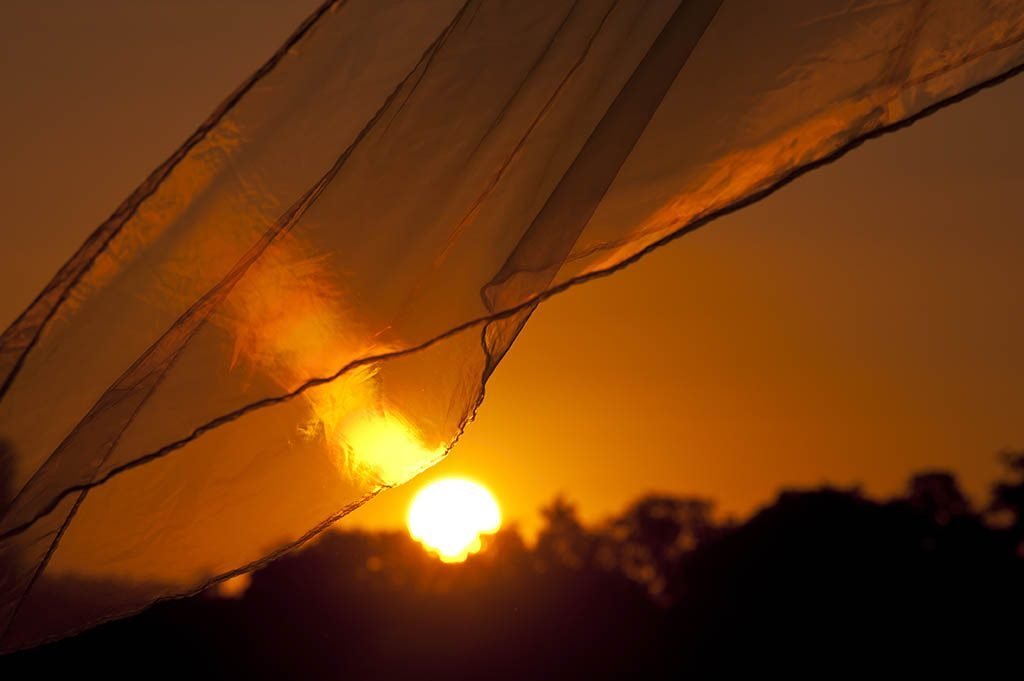No matter if you’re a camping expert, or looking to go on your first trip, the thought of, “how to keep a tent cool” has surely crossed your mind. No one likes living or sleeping in a boiling, sweaty, stuffy mess, which is why learning how to keep cool in a tent is an essential part of summer camping.
Tents don’t just get hot in the summer, though. Body heat is a huge factor when it comes to a hot tent, even if it’s just one or two of you inside.
When it’s more than 3 or 4 people, well, that’s more body heat, and a much higher chance for things to warm up. Apart from the unbearable feeling of stale heat, it can also cause condensation, which isn’t fun to deal with.
So, how to stay cool while camping? Today we’re going through the most popular options used by camping enthusiasts to cool things down and have a more comfortable experience.
We’ll explore how each solution works, so that you can decide which one will best suit you. Stay tuned until the end where we reveal our best tips for staying cool when there’s no electricity around.
Page Contents:
5 Top Tips to Keep a Tent Cool This Summer
1. Using a Tent Air Conditioner
When nature’s AC just isn’t cutting it (we’re talking about wind here) then one of the most obvious choices is a tent air con. In our opinion, they’re the easiest and fastest way to cool things down, but it’s important to consider that they can be quite expensive.
That’s where portable air cons for tents come in, because generally they’re not as bulky. They won’t cool the entire tent down as fast as a full-on heavy-duty AC unit. But there are some compact models out there that can drop the temperature inside a tent using water tanks and high-speed fans.
We’ve reviewed the best tent air conditioners before, so you can check them out to find the perfect one.
Window or Wall AC Units
These are the big guys, and are fitted onto the tent from the outside, kind of like on walls or windows of buildings. Technically they’re somewhat portable, because you can take them for car camping, but they can be very heavy.
Usually, they insert through a vent on the tent, so make sure your shelter has a vent to accommodate to its size.
Portable or Compact AC Models
Portable air cons for tents are typically much smaller than the above mentioned. In our previous reviews, we’ve mostly included these smaller kinds of ACs. However, there are some that are larger, but less hefty than window AC models.
Portable ACs can come with handles to carry around with ease, simple controls, moveable shutters for directional breezes, and LED lights for a modern touch.
Most of them have a runtime of around 8 hours on low speeds, making them a decent option for keeping cool while sleeping. They won’t use up as much power as window ACs but give less powerful airflow.
2. How About a Camping Fan?
Ah, the age-old fan. These are arguably the most traditional devices used to keep people chilled, but does that mean they’re always the best? Well, all I can say is that there’s a reason why these have been used for so many years – because they do work.
Whether you want to use one or not depends on personal preference, and whether you’d prefer an icier cooling solution instead.
Tent fans can be found in heaps of sizes, shapes, and designs. You can find models that are lightweight and fit in your pocket or bag. Or, you can take the more traditional route with industrial floor fans.
Check out our previous reviews on the best camping fans for tents and outdoors to look at your options.
Cool features you can find in some camping fans:
- Modernized design
- Built-in hook to hang on the roof
- Flat base to use as a floor fan
- Integrated lighting, so you don’t need to bring an addition lighting device
- Solar power for energy efficiency
- USB rechargeable batteries
3. Are Outdoor Misting Fans a Good Choice?
Misting fans for outdoors are another widespread option – they’re kind of like an air con and fan hybrid. These act as humidifiers as well, which helps to keep your skin, nasal airways, and eyes moisturized.
Typically, they’re made up of a regular fan, with some nozzles that are attached on the front that emit a fine mist. Outdoor-specific ones are commonly standing designs, but we have seen more compact ones that you can use inside your tent.
If you’re camping with a large capacity tent, though, you can use a standing fan that has an adjustable height.
The main thing to consider with these is that some models can make the surrounding area wet. If this is the case, we recommend laying some towels underneath it, or using it to cool you down while outside and leave the tent disassembled during a hot day.
That way, you can maintain a comfortable body temperature all day and cozy up in a cool tent that’s been out of the sun.
Take a look at our in-depth review on the best outdoor misting fans, but in the meantime, we’ve summarized what you should look for before buying.
Things to look out for in misting fans:
- Range of speed settings or mist adjustments
- Weatherproof materials like strong ABS plastic and rubber tubing
- Type of required power source
- UV or rust resistance
- Oscillating or tilting head
4. Is a Handheld Misting Fan Worth it?
It’s all in the name with these pocket rockets – these are mini misting fans that you can hold with one hand.
Now, obviously these aren’t going to produce as much power in terms of mist and air speed as you’d expect from an AC unit, or regular sized misting fan. But that’s exactly the case here – you can’t expect it to produce as much power because it’s not made for that.
Small misting fans that you can hold with your hand are more intended for cooling down one part of your body at a time. Since they’re designed to be highly portable, they’re used on-the-go or in situations where you need a rapid form of heat relief.
Since these are so compact in size, they typically use very little power. This makes them safe to use in tents because they won’t overheat.
Why handheld misting fans are great for tents:
- Exercise – Even if you’re going on a fairly calm camping trip, chances are you’ll find yourself on a walk or quick hike. Other campers enjoy going on frequent hikes, fishing, hunting, playing games, going horse riding, playing sports, boating, bird watching, and so on. No matter what kind of camping trip you’re on, having a mini misting fan on-hand will help you cool down on the spot. Chill down before getting in the tent, and once you’re in, you’ll feel much more relaxed than if you went inside hot and sweaty.
- Stagnant heat – This is the type of heat that rears its ugly head when there’s not a gust of natural air in sight. It can be overwhelmingly uncomfortable to deal with, as it can feel like there’s no escape. If there’s no power, or you forgot to bring along an AC device, a handheld fan with mist can go a very long way to cooling you down. Spray some mist on the back of your neck, wrists, back of the knees, and face, and you can cool right down thanks to the air from the accompanying fan. When you’re inside your tent trying to gaze at the stars, or cool down before sleeping, these mini misters can be a live saver. There’s no need to turn on a bunch of buttons or settings, as they take one or two clicks to use.
- More than a traditional fan – One of the best things about these types of fans is that they can lower your temperature faster than a regular fan, even despite their smaller size. That’s because of the mist component, which evaporates in the air and takes the heat with it. Ambient air temperature is eventually reduced, creating a faster chilling effect.
- Multifunctionality – While this isn’t the case for all models, there are so many on the market that offer various design elements. These can include the ability to transform into a desk or floor fan, continuous or manual mist pumps, large capacity water tanks, low energy consumption, and built-in nightlights.
These features can all come in handy inside your tent – dual positioning and mist options let you use it handsfree, low energy consumption means less recharges and more time relaxing, and nightlights help you see in the dark while going to the bathroom or rummaging through gear.
5. Tips & Tricks to Keep Cool in a Tent Without Power
In addition to using any of the above options, there are other measures you can take to feel colder inside a stuffy tent. Here are some of our favorites:
Before & beginning:
- Bring a summer-friendly tent – this means it should be specially designed for hotter conditions using lighter fabrics like polyester, cotton, or nylon, a 2-3 season model would be ideal here.
- You can also consider a blackout or darkroom tent, that keeps temperatures to a minimum, while
- Assemble your tent in an area with shade, and that has a reasonable amount of foliage and treeline surrounding, this allows the trees to absorb heat and light from the sun rather than the tent fabric.
During your trip:
- Leave windows and vents open during the day to let a natural breeze flow through. As we all know heat rises, so this includes taking off the rainfly at night time to let body heat and stuffy air rise and escape.
- Take down the tent during very hot days and reassemble when it’s cooler. For a more expensive alternative, take a canopy and erect it over the tent during hot afternoons.
- Install a reflective sheet on top of the tent roof to encourage the rays from the sun to bounce off and away from the interior.
Sleep & body temperature:
- Sleep without a sleeping bag on super warm nights.
- Stay hydrated by drinking lots of water.
- Immerse towels, rags, or your clothes in water (from a lake or river if you don’t want to use your drinking supply) and place on the back of the neck.
- Have a cold shower with a camping shower, or shower room if you’re on a campsite with bathing facilities.
Conclusion
Using our tips, tricks, and reviews of the most well-known methods for keeping a tent cool, you’re ready to go on your next warm-weather camping trip. Remember to think about the type of camping you’ll be doing and how large the tent is, as this will affect the portability, size, design, and type of cooling system you should choose.


